Are you tired of rummaging through a messy pantry only to find the same items over and over again? Do you want to know how to organize pull-out pantry drawers so that you can easily access the items you need? Then read on!
Many people struggle with pantry organization, making it difficult to find what they need when they need it. It’s easy for items to get lost amidst the chaos, leading to duplicate purchases and unnecessary frustration.
Trust me; I’ve been there too. As someone who wasn’t always a natural-born organizer, I understand the challenges that come with trying to maintain an orderly pantry.
But here’s the good news: effective pantry organization can transform your kitchen experience, making it more efficient and stress-free. With a well-organized pull-out pantry drawer system, you’ll know exactly where everything is, eliminating the hassle of searching for ingredients while you’re cooking or baking.
In this guide, we’ll walk you through 6 simple steps to help you organize your pull-out pantry drawers like a pro. Say goodbye to the days of pantry chaos, and hello to a more streamlined and enjoyable time in the kitchen!
Benefits of Having Pull-out Drawers
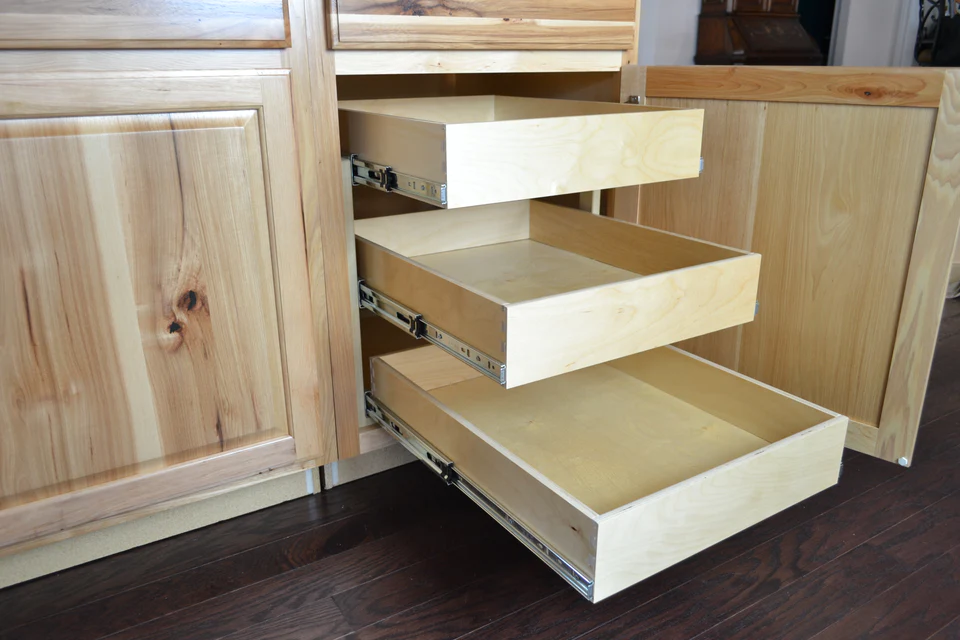
Pull-out drawers are a game-changer when it comes to home organization. These innovative storage solutions are designed to slide out smoothly, allowing you to access your belongings easily. They can be installed in various areas of your home, such as the kitchen, bathroom, and bedroom, providing practical and efficient storage options.
Here are some benefits of installing pull-out drawers in your home and how they can help you create a more organized and clutter-free living space.
① Space Optimization
Pull-out drawers make the most of available storage space, especially in small or tight areas, by utilizing the full depth of cabinets and shelves.
② Improved Organization
With pull-out drawers, you can easily categorize and arrange your belongings, making finding items easier and keeping your space clutter-free.
③ Easy Accessibility
The sliding mechanism of pull-out drawers allows for smooth access to items stored at the back of cabinets, eliminating the need to bend, stretch, or remove other items to reach what you want.
④ Customization Options
Pull-out drawers come in various sizes, materials, and designs, allowing you to tailor them to your specific needs and preferences.
⑤ Enhanced Aesthetics
Pull-out drawers contribute to a cleaner, more streamlined look in your home by keeping items neatly organized and tucked away.
⑥ Increased Efficiency
Having an organized and easily accessible storage system saves time and reduces frustration when searching for items, leading to a more efficient daily routine.
⑦ Reduced Wear and Tear on Items
Proper organization and storage within pull-out drawers help protect your belongings from damage caused by overcrowding or stacking.
⑧ Better Inventory Management
With everything in its designated place, it’s easier to keep track of what you have and what needs replenishing, preventing over-purchasing and food waste.
⑨ Safety Benefits
Pull-out drawers can help prevent accidents caused by reaching for items in high or deep cabinets and reducing the risk of items falling out when opening cabinet doors.
⑩ Increased Home Value
Well-designed and functional storage solutions like pull-out drawers are attractive to potential homebuyers, potentially increasing the value of your home.
How To Organize Pull-Out Pantry Drawers in 5 Steps

Now that you know the benefits of pull-out drawers, it’s time to get organized! Here are six simple steps to help you create a well-managed and efficient pantry storage system.
Step ①: Declutter
The first step in this process is decluttering; trust me, it will make a world of difference. Let me walk you through why decluttering is essential and how it can make the rest of the organization process a breeze.
Think about all those expired cans or half-eaten bags of chips that have been sitting in your pantry for who knows how long. They’re taking up valuable space, making it harder to find the items you need for meal preparation.
By decluttering, you’re creating a clean slate to work with, making organizing so much easier. Plus, it’s an excellent opportunity to check expiration dates and toss out anything that’s no longer safe to consume.
Now, I know that decluttering can sometimes feel overwhelming, especially when we’re attached to certain items for sentimental reasons. But here’s the thing: it’s important to strike a balance between holding onto meaningful items and maintaining a practical, organized pantry.
Ask yourself if that old glass jar of jam from your vacation five years ago is really worth keeping or if it’s just taking up space and collecting dust. Remember, the goal is to create a functional and efficient pantry where you can easily find what you need.
Step ②: Group Similar Items
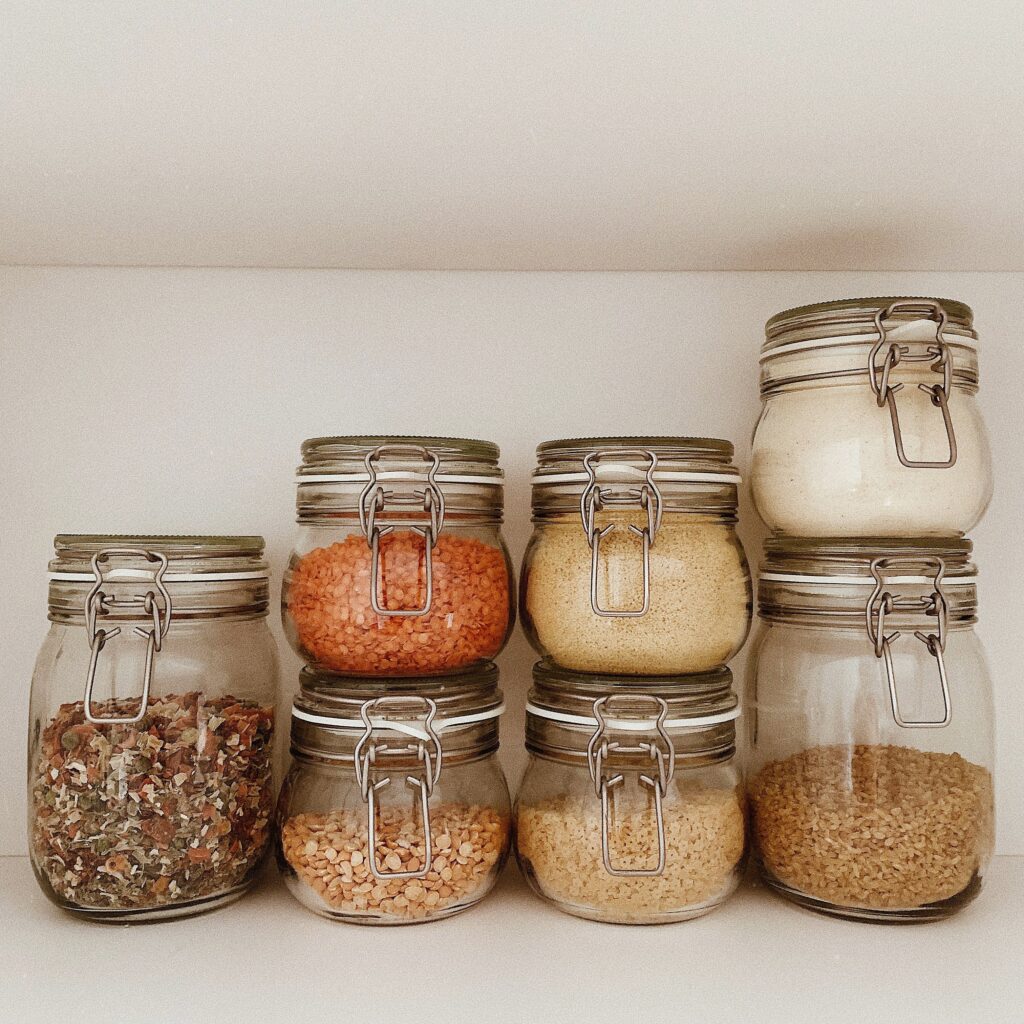
Now that you’ve decluttered, it’s time to start grouping similar items together. This step is crucial as it ensures that no matter how many times you need to visit the pantry drawers, you will easily find what you’re looking for.
Start by grouping items like canned goods, soup, and pasta sauce together. Not only does it make it easier to spot what you need, but it also allows you to create a comprehensive inventory of everything you have. Grouping items also helps you avoid purchasing duplicates and wasting money on things you already have.
Think about how you use your pantry items when grouping them together. For example, if you’re a fan of baking, it makes sense to group all your baking ingredients in one drawer.
Similarly, if you drink tea or coffee often, group your mugs, tea bags, and coffee supplies for easy access. By organizing your pantry drawers based on your daily needs and habits, you’ll create a system that works seamlessly for you and your household.
Another helpful tip is to group items by their size and shape. For instance, store tall and slender items like bottles of oil and vinegar together while keeping shorter and wider items like jars of peanut butter and jam in a separate section. This way, you can optimize space and make grabbing the items you need easier without disturbing the rest of the drawer’s organization.
Step ③: Invest in Labels
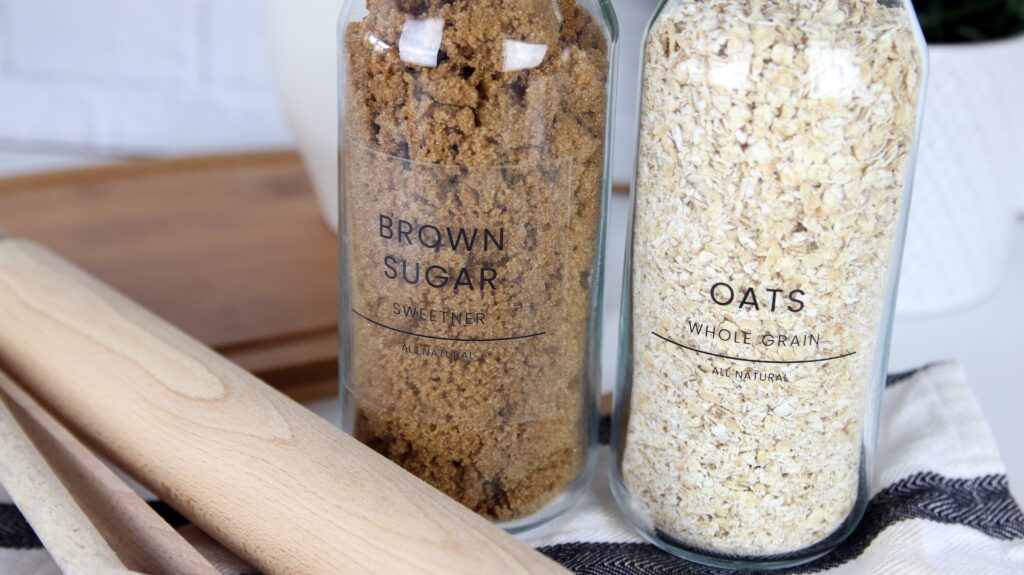
Labels are like magic little helpers for keeping your pantry organized. They help you quickly identify what’s inside containers and baskets and serve as friendly reminders of where everything belongs. Think of them as your personal kitchen assistants, guiding you to find exactly what you need without any guesswork.
There are so many creative ways to label your pantry items. You can use pre-made labels or make your own using a label maker or even just a marker and some tape. Choose a style that matches your personality and your kitchen’s aesthetic, whether that’s minimalist and sleek or colorful and whimsical. The key is ensuring the labels are easy to read and durable enough to withstand daily use.
When labeling your pantry items, be as specific as possible. For example, instead of simply writing “flour,” consider specifying “all-purpose flour” or “whole wheat flour.” This way, you’ll know exactly what you have on hand, making meal planning and grocery shopping more efficient.
Step ④: Utilize Storage Solutions
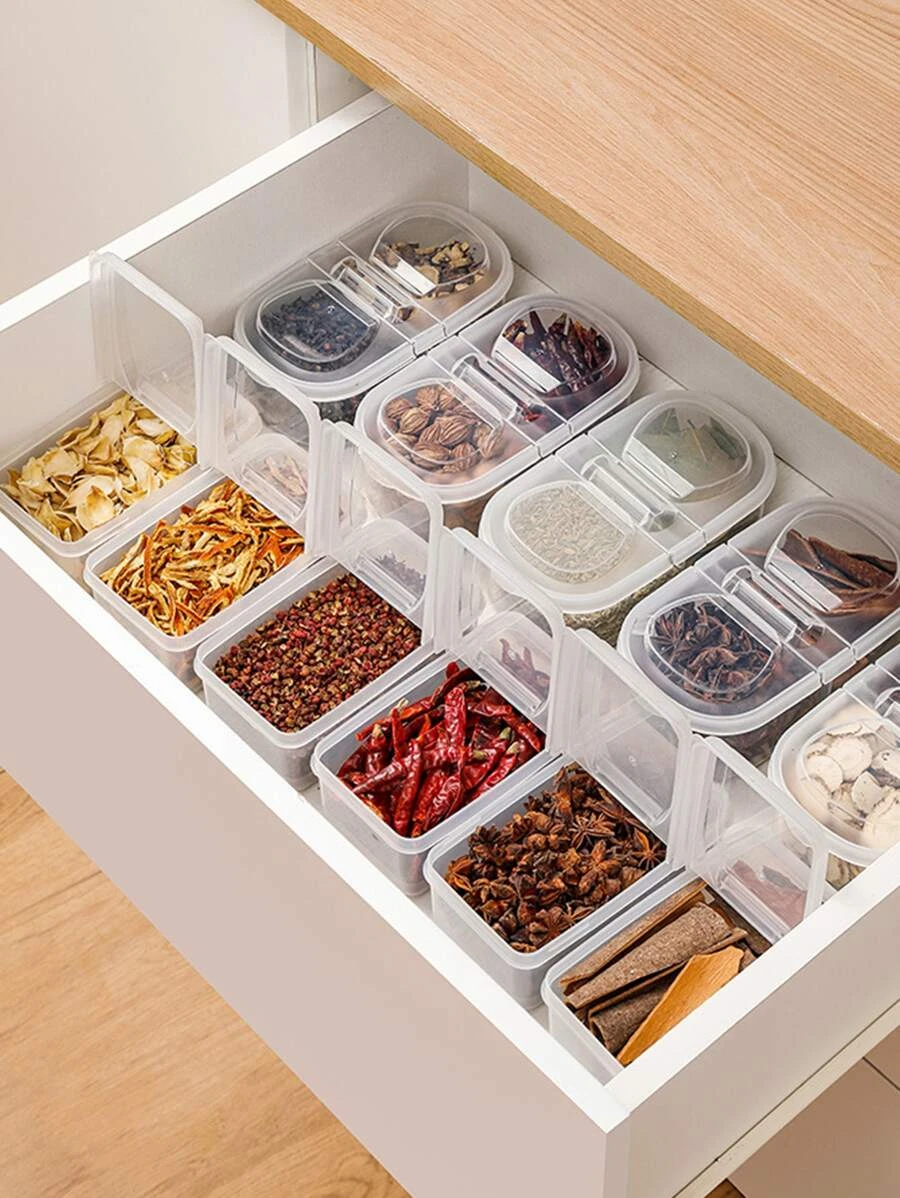
Storage solutions come in all shapes and sizes and can truly transform your pantry organization. Think of them as the secret ingredient to maintaining a clutter-free and efficient kitchen. Some popular options include clear containers, baskets, bins, dividers, and tiered shelves. The key is to find storage solutions that work best for your specific needs and the available space in your pull-out drawers.
For example, clear containers are fantastic for storing dry goods like pasta, rice, and cereal. They keep your food fresh and allow you to see exactly what’s inside, making it easier to find what you need.
On the other hand, baskets are great for corralling smaller food items like snack bars, spice packets, or baking supplies. Dividers and tiered shelves can help you make the most of vertical space, ensuring every inch of your pull-out drawers is put to good use.
When choosing food storage solutions, consider the dimensions of your pull out drawers and the sizes of the items you’re storing. Measure your kitchen cabinet space and the height between shelves before purchasing any storage products to ensure they fit perfectly.
Step ⑤: Maintain And Refresh
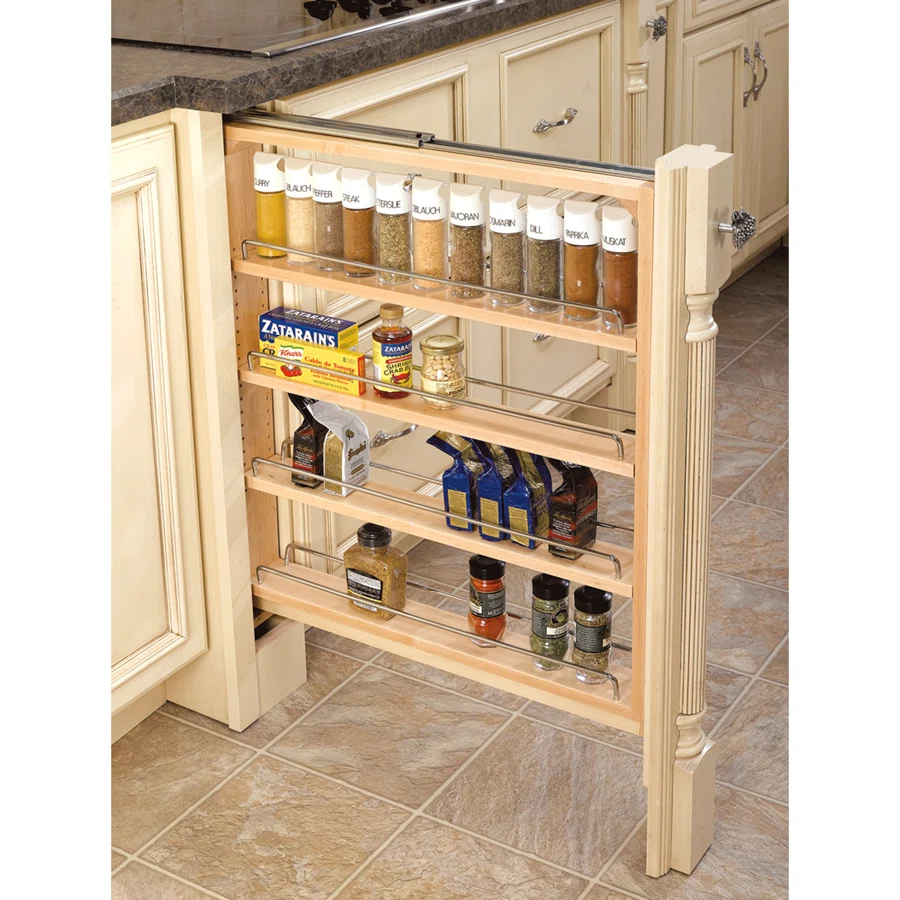
After all that hard work, the final and most crucial step is maintaining and refreshing your pantry drawers to keep everything in check. So, how do you go about doing that, you may ask? Let me help you with that!
Look at your pantry situation and begin decluttering again: Yes, I know it may sound like task repetition, but keeping your pantry up-to-date with your current needs is vital. As time passes, our requirements and preferences change as well.
Therefore, remove everything from your pantry drawers, re-evaluate what you need and can get out, and put things back accordingly.
✅ Cleaning is Essential
Cleanliness is next to godliness, and your pantry is no exception. Make sure to wipe the pantry shelves and drawers, vacuum them, and keep them free of dust and crumbs. This helps maintain a clean and organized space and keeps pests and bacteria at bay, ensuring the health and safety of your family.
✅ Conduct Regular Inventory Checks
Every few weeks or months, depending on your needs, take a moment to review the contents of your pantry drawers. Check for any expired items, duplicates, or items you no longer use. This routine will help you stay on top of your pantry organization and make grocery shopping more efficient, as you’ll know exactly what you need to restock.
✅ Adjust Your Organization System as Needed
As your lifestyle and preferences evolve, so should your pantry organization ideas. Don’t be afraid to make adjustments to your drawer layout, storage solutions, or labels if they no longer serve your needs effectively. The goal is to maintain a pantry organization system that works seamlessly for you and your household.
✅ Create a Maintenance Schedule
To ensure your kitchen pantry stays in tip-top shape, consider creating a maintenance schedule that works for you. It could be a weekly, bi-weekly, or monthly routine – whatever suits your needs best. Having a consistent schedule will help you stay on track and prevent your pantry from becoming disorganized again.
Frequently Asked Questions
Q: How can you effectively use a kitchen cabinet organizer and kitchen pantry shelf to improve organization and accessibility in your cooking space?
Kitchen cabinet organizers and pantry shelves can be game changers when making your cooking space more organized and accessible. With a cabinet organizer, you can maximize the space in your cabinets and easily see and access your pots and pans without shuffling them around. Pantry shelves are perfect for holding all your nonperishable items, allowing you to easily find what you’re looking for and preventing food waste.
Q: What pantry staples can be stored in mason jars for a visually appealing and organized kitchen space?
From dried beans and rice to flour and sugar, there’s no limit to what you can store in a mason jar. And with their clear glass construction, you’ll be able to easily see what you have on hand, making meal planning and grocery list-making a breeze. Plus, they’re reusable and eco-friendly, so you can feel good about making a sustainable choice for your home.
Q: How can you optimize your pantry space for better kitchen organization and increased functionality?
Start by taking everything out of your pantry and sorting it into categories such as canned goods, snacks, and baking supplies. Next, invest in some storage solutions such as clear plastic bins or baskets to group items together. You can also use door-mounted racks or organizers to use any unused space. Finally, don’t forget to label everything to make it easy to find what you need.
Q: What are some creative ways to utilize the pantry cabinet door for extra storage?
It’s the perfect place to get crafty and create extra storage that won’t take up valuable floor or counter space. The possibilities are endless, from mounting small baskets to hooking up a spice rack. Imagine having all your go-to spices just a reach away or using the inside of the door for an herb garden! Plus, it’ll make cooking even more efficient and enjoyable.
Q: Why is it important to declutter your pantry regularly?
Taking the time to declutter the pantry regularly can make meal prep a breeze, save space, and even help cut down on food waste. Think about it – how often do forget cans or expired packages go unnoticed when you can’t see what’s lurking in the back of those cluttered shelves? By taking the time to assess and clear out your pantry regularly, you’ll have a better understanding of what you actually have on hand, leading to more efficient meal planning and potentially saving money in the long run. Plus, with a neat pantry, your inner home chef will thank you.
Final Words
Giving your pull-out pantry drawers a little TLC can make a world of difference in your daily kitchen adventures. By categorizing items, utilizing clear containers, and adding some nifty labels, you’ll be amazed at how much time and stress you save during meal prep and grocery shopping.
I encourage you to give these steps a try – you might just find yourself falling in love with your kitchen all over again! And remember, I’m always here to lend a helping hand or share extra tips if needed.
Therefore, go ahead and take this small, manageable step towards a more organized and harmonious life. You’ve got this! Let’s make pantry chaos a thing of the past and embrace the joy of a beautifully organized space.


